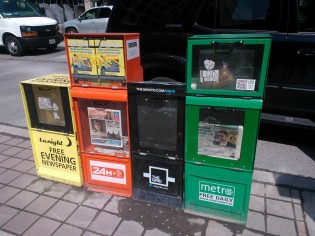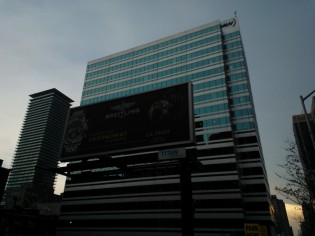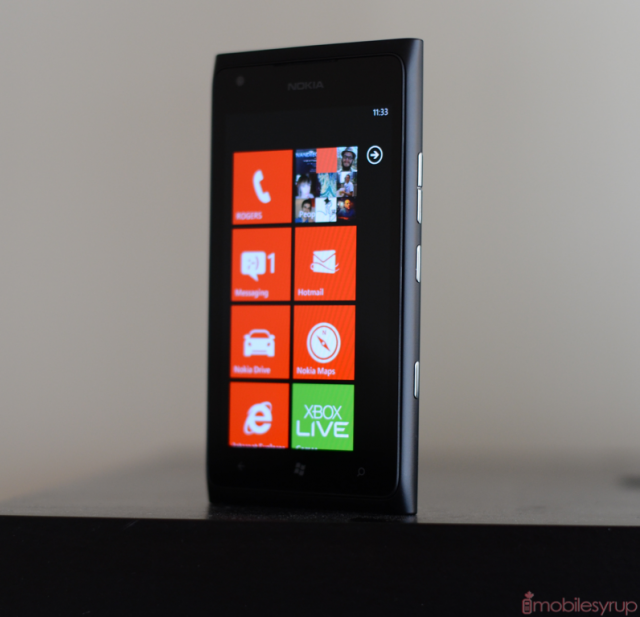
The Nokia Lumia 900 is the phone that many Windows Phone lovers have been waiting for since the first devices were released in October 2010. While not drastically different internally than its forerunners — eighteen months later no Windows Phone can boast a dual-core processor or high-resolution screen — the 900 culminates in perhaps the most refined and effortless-feeling Windows Phone experience to date.
And a lot has changed in the Windows Phone world since its inception, too. The software has received a huge update in Mango, and the app ecosystem has rapidly, and impressively, expanded. Considering Rogers is selling the Lumia 900 for under $100 on a 3-year term, does it have what a smartphone needs in order to lure buyers away from the iPhone and Androids out there? Let’s take a look.
Specs:
– Windows Phone 7.5 Mango
– 4.3-inch 480×800 pixel ClearBlack AMOLED display
– 1.4Ghz Qualcomm Snapdragon APQ8055 S2 SoC
– 512MB RAM / 16GB internal storage (no expandable storage)
– 8MP camera /w LED flash, 1MP front camera
– 720p video capture
– WiFi (b/g/n), A-GPS, Bluetooth 2.1
– 127.8 x 68.5 x 11.5 mm
– 160g
– 1830mAh battery
– HSDPA 850/1900/2100Mhz, LTE 700/1700/2100Mhz
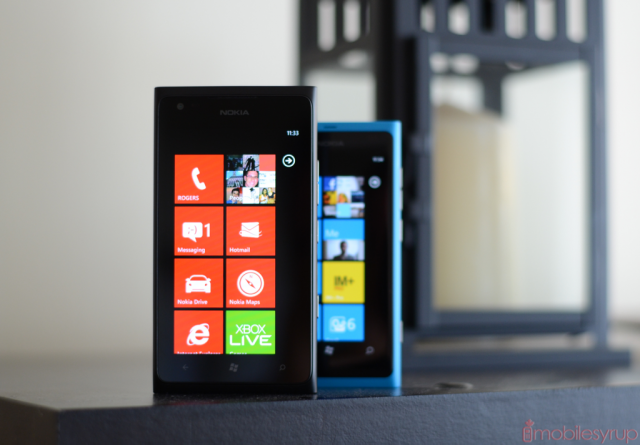
Design
The Lumia 900 could be correctly construed as a slightly larger variant of the 3.7-inch, 142g Lumia 800, which we reviewed for TELUS in March. But there are a few notable design changes that affect the 900 negatively, most obvious of which is the replacement of the gorgeous curved Gorilla Glass for a flat, sharper alternative. This cuts down on the thickness of the phone, which is already on the hefty side, but it detracts from its head-on attractiveness.
Nevertheless, the Lumia 900, sold exclusively by Rogers in a matte black finish, is a stunning piece of hardware. It feels substantial and well balanced, as it should, made from a single piece of etched polycarbonate. Its buttons are coloured shiny chrome with plenty of give, spaced intelligently on the right side of the device. The bottom is home to the mono speaker and microphone combo, bezelled in tiny circles like the front-side headpiece.
The 4.3-inch screen is the same resolution as its 3.7-inch kin, but has better colour reproduction and overall clarity due to a full RGB palette. Contrasted with the Lumia 800’s Pentile display, text actually looks sharper on the screen. Blacks are rich and endless thanks to the AMOLED technology; whites take on a purple tinge at times, more so than the average OLED display, pointing to poor calibration more than a hardware defect.
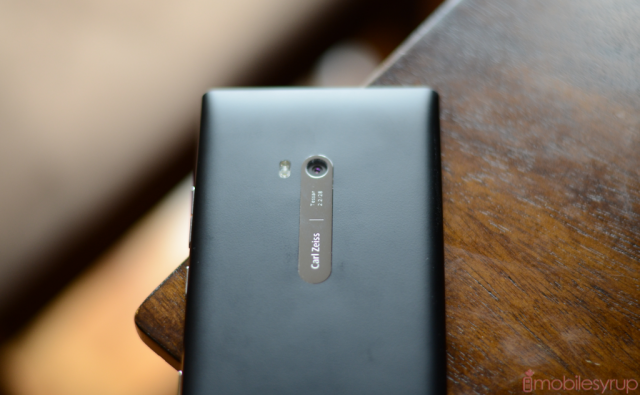
The back of the device is highlighted by a centre-placed camera sensor and matching LED flash. The Lumia 900 boasts a Carl Zeiss lens with f/2.2 aperture, and a tiny 8MP sensor, boasting of excellent photo quality. As we’ll see later, this is true in only some circumstances.
Nokia has basically enlarged the existing Lumia 800 to fit a more North American-style trend: bigger is better. Unlike the latest crop of high-resolution Android devices, which benefit from the extra screen real estate, I far prefer both the look and feel of the 800. Not only are all the touch points more easily accessible, but the curved glass and slightly slippery polycarbonate fit more comfortably in the hand than the larger 900 casing.
This is not to impugn the 900 in any way — it is still one of the most attractive devices on the market today — but it six months after the debut of the 800, and the subsequent release of the HTC One X, the 900’s design is just slightly less astonishing.
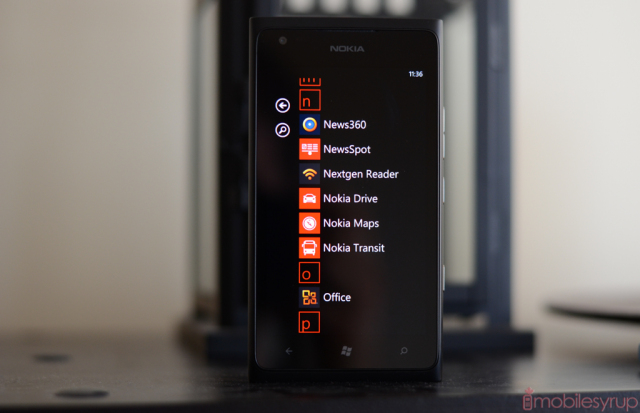
Performance & Operating system
The Lumia 900 runs Windows Phone 7.5 Mango, and the version I reviewed had the LTE connectivity fix already applied. As a result, the smooth operating system along with the valuable addition of high-speed LTE helped the phone feel faster than any Windows Phone device I’ve used.
Windows Phone is an extremely well-designed operating system that prioritizes performance above all other facets. It is beautiful, yes, in a dual-toned kind of way, but what was intriguing and unique in October 2010 has become staid in mid-2012. The Metro interface, with its big square Live Tiles and long lists of applications, is in dire need of some better management tools. The lack of essential tools such as homescreen folder creation ensures an ungainly flow of live tiles, while the toast-based notification system has become a hindrance. After a notification is received, it is often impossible to tell which app it was from, and even if you have a live tile pinned the solution is often a small incremented number placed on the corner. Both iOS and Android have robust and permanent notification systems that ensure you won’t miss something until you manually dismiss it. The OS’s inability to share or delete multiple images is frustrating.
On the same token, the camera interface and email app is astoundingly intuitive: Microsoft made some fantastic decisions paring down users’ options to the bare minimum, leaving just you and the screen. The problem with Windows Phone 7.5 is that there are so many glimpses of greatness interspersed by seemingly confounding omissions.
The Lumia 900 runs a 1.4Ghz single-core Snapdragon S2 processor and 512MB RAM, and they collaborate to make an overall pleasant experience when using the operating system. Loading apps is quick and consistent, and typing on the keyboard is a joy, especially on the larger 4.3-inch screen. Timed tasks such as loading a webpage or a Twitter timeline have been been cut in half from the Lumia 800 due to the incredibly-fast 75Mbps Rogers LTE connection, which falls back to 21Mbps on HSPA+.
The single-core processor shows its aging side when loading pages with large amounts of Javascript, though the blame has to be shared with Internet Explorer 9. Many modern HTML5-powered web pages struggled to render at all, or displayed incorrectly when compared to mobile Safari or Chrome for Android.
Overall, the Lumia 900 felt solid and fast, and provided an extremely similar experience to the Lumia 800. The bigger enlarges all the Windows Phone assets, and while text is very readable and images reasonably sharp, it’s difficult to avoid noticing how many fewer lines of text are rendered on a web page or email due to the WVGA resolution screen.
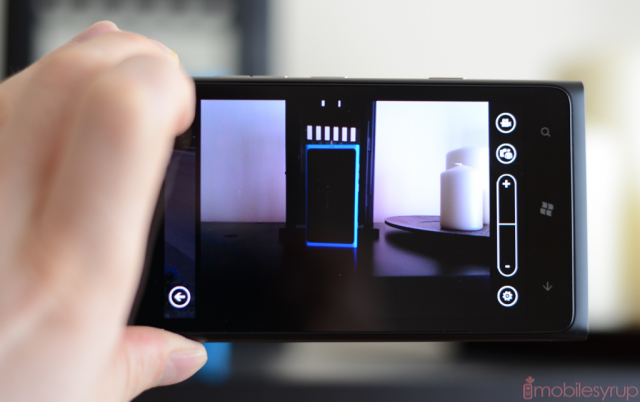
Camera
The Lumia 900 has an identical camera sensor to the 800, but Nokia has optimized it for speed and clarity. I found that, like the 800, daylight photos were excellent, with plenty of gorgeous details and luscious colours. But introduce a bit of darkness to the scene and noise becomes a big problem, leading to an unpleasant level of grain. While all phone camera sensors suffer from this issue to some extent, the Lumia series conveys itself especially poorly in such scenarios.
I found that the Lumia 900 had problems automatically adjusting exposure levels to complement the amount of ambient light. This led to washed-out photos with poor white balance, though many of the issues should be attributed to its small sensor.
Similarly, the Lumia 900 had problems focusing on nearby objects. Its macro-specific mode failed to differentiate between fore- and background objects, even if there was plenty of space between the object and the lens. Smartphones such as the iPhone 4S and HTC One X had no such problems.
It’s worth mentioning that the Lumia 900 has a front-facing camera with a 1MP resolution. The bundled Tango video calling app, along with Microsoft’s newly-released Skype, worked great when I attempted to connect to loved ones around the world.
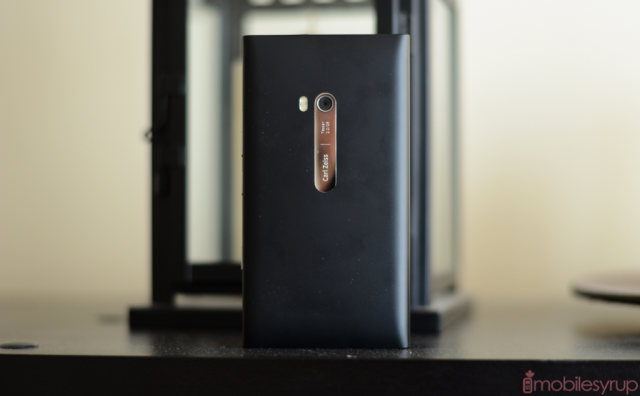
Battery Life
The Lumia 900 had superlative battery live for a LTE device. Despite using a last-generation solution, the industry-standard Qualcomm MDM9200, the 1830mAh cell got me through the day and into the following morning in most cases. This is the natural advantage of Windows Phone, which prevents all but the most important apps and services from running in the background. This is both a blessing and a curse, though: there are no API calls for Skype to detect incoming calls when the app is closed. On the other hand, since only the foreground app is using battery, with precious system resources saved for incoming push notifications, calls and text messages, overall uptime tends to be higher than the average Android device.
Nokia’s Lumia 900 is the first LTE-powered Windows Phone I’ve tested, and for the most part acquits itself extremely well. Considering how power-hungry the MDM9200 was in devices such as the HTC Raider and Samsung Galaxy S II LTE, the Lumia’s 18-24 hour uptime is pretty remarkable.
In our battery test suite, which loops a video with the screen on while the device is connected to the cellular network, the Lumia lasted for 6 hours 38 minutes.
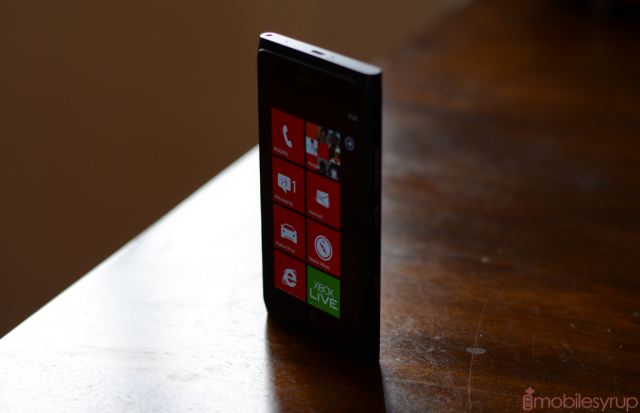
Network Speeds and Call Quality
The Lumia 900 does a great job helping Windows Phone feel significantly faster — a smooth experience is not always a fast experience. The LTE connection improves load times and and lowers latency in the web browser, loading Twitter or Facebook feeds or downloading large apps from the Marketplace. This is important because due to the almost-identical hardware in most second-generation Windows Phone, it’s often difficult to tell the performance difference between a $250 Lumia 710 and a $550 Lumia 800. At the very least the Lumia 900, when using the internet, feels like the fastest and smoothest Windows Phone on the market.
We were able to achieve speeds of nearly 25Mbps down and 17Mbps up when doing bandwidth and latency tests over the Rogers network. Compared to anemic average 3-5Mbps results of HSPA+ devices, this is a big win for the Lumia.
Call quality, in traditional Nokia style, was excellent both with the headpiece and through the speaker. Due to the location of the speaker, sound through the grill is aimed straight at the user when the phone is placed on its back, a nice touch that made conference calls quite enjoyable.
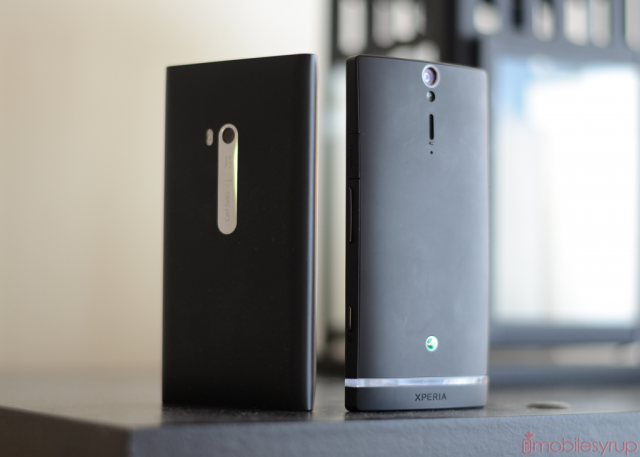
Ecosystem
Nokia bundles its excellent Drive app with the Lumia 900. This is a free service that provides on- and (since version 2.0) offline turn-by-turn navigation in a beautifully laid-out user interface. The device had no problem locking on to and keeping a GPS signal, either. The large 4.3-inch screen is much better suited for such activities, and with a sturdy car dock the phone stands in very well for a dedicated GPS unit.
The company also makes available its fantastic Nokia Maps, Transport, and Creative Studio apps in the Windows Phone Marketplace. They do a great job of filling in some of Windows Phone’s app holes, and since they’re only available to Nokia users, they’re all the more important. Certainly this risks creating fragmentation within the WP7 ecosystem, but Nokia is using them as a value-add more than a reason to purchase the phone. Unlike Flipboard’s exclusive agreement with Samsung, Nokia creates all these apps in-house, largely negating the fragmentation argument.
Rogers bundles its One Number portal with the phone, along with its UrMusic and My Account apps. Blissfully missing are the Android-centric Ringbacks, Ringtones and Games shortcuts which equate to nothing more than bloat. And Microsoft has made it possible to uninstall any and all apps from its Windows Phone devices, so if you don’t like any of Rogers’ or Nokia’s inclusions, you can get rid of them without hassle.
More troubling is the persistent idea that Windows Phone just doesn’t have the big-name app selection necessary to carry into a solid third place. While Nokia and Microsoft are doing everything they can to woo (and pay) developers into building apps, the lack of mainstream interest in the platform seems to be keeping big names away. Furthermore, while staple apps such as Twitter, Facebook, Evernote, Rdio and the like are available for Windows Phone, many of them lack both the features and consistent upgrade pattern that iOS and Android users take for granted.
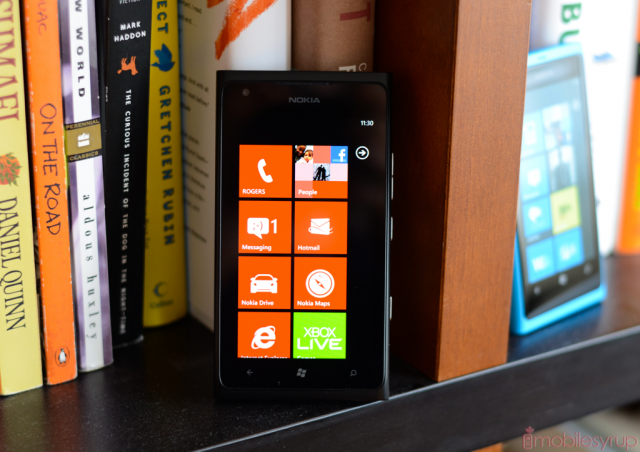
Conclusions
The Lumia 900 is Windows Phone’s first really important “hero” device in North America. Its little brother, the Lumia 800, was never launched in the United States, so a lot is riding on the 900’s AT&T release. But TELUS was kind enough to release the 800 earlier this year to great acclaim, and the Rogers Lumia 900 release was plagued with data connectivity issues and a subsequent $100 rebate offer for early adopters that got in the way of a flawless debut. Granted, Nokia handled the situation with aplomb, but it took three extra weeks to get the device into the hands of journalists (hence the lateness of this review).
Rogers is selling the Lumia 900 only in black, and for $99 on a 3-year term or $524.99 outright. Considering the number of same-same Android devices in its lineup, Rogers has an opportunity to push the Lumia really hard to new smartphone users who would appreciate it. It may not do everything, but Windows Phone does so many things well, and so smoothly, that its inherent attractiveness is hard to overlook. It may not get the carrier attention of Android, or the marketing push of the iPhone, but in many areas such as camera and email, Windows Phone provides a superior experience.
Because of its size, I can’t say I prefer the Lumia 900 to the easier-to-handle 800. But I like them equally in many ways, and in a few others I’d take the Lumia 900 in a heartbeat. For anyone looking to make the transition to LTE without waiting on the iPhone or suffering the battery drain of Android, the Lumia 900 is the way to go.
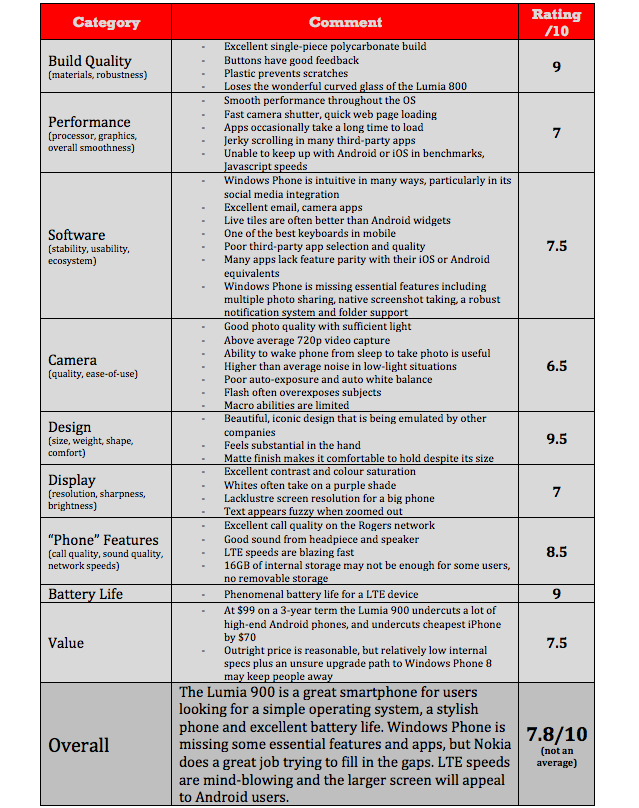
MobileSyrup may earn a commission from purchases made via our links, which helps fund the journalism we provide free on our website. These links do not influence our editorial content. Support us here.

